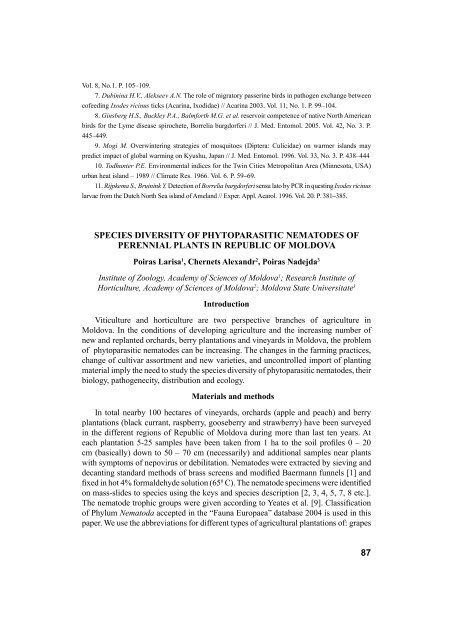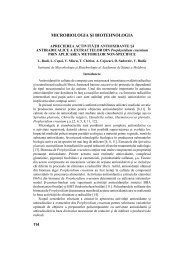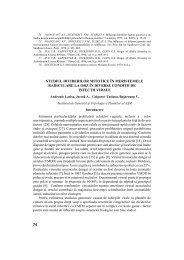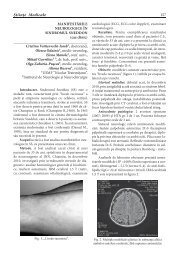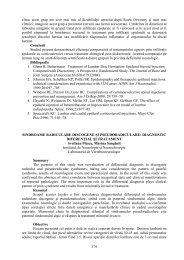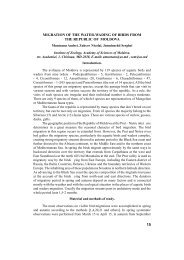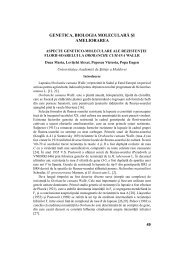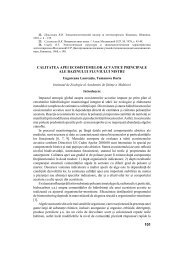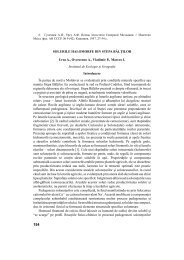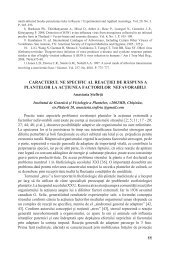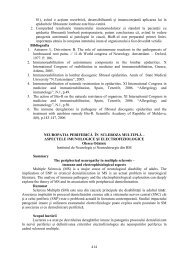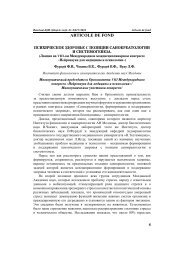198 CUPRINS
198 CUPRINS
198 CUPRINS
You also want an ePaper? Increase the reach of your titles
YUMPU automatically turns print PDFs into web optimized ePapers that Google loves.
Vol. 8, No.1. P. 105–109.<br />
7. Dubinina H.V., Alekseev A.N. The role of migratory passerine birds in pathogen exchange between<br />
cofeeding Ixodes ricinus ticks (Acarina, Ixodidae) // Acarina 2003. Vol. 11, No. 1. P. 99–104.<br />
8. Ginsberg H.S., Buckley P.A., Balmforth M.G. et al. reservoir competence of native North American<br />
birds for the Lyme disease spirochete, Borrelia burgdorferi // J. Med. Entomol. 2005. Vol. 42, No. 3. P.<br />
445–449.<br />
9. Mogi M. Overwintering strategies of mosquitoes (Diptera: Culicidae) on warmer islands may<br />
predict impact of global warming on Kyushu, Japan // J. Med. Entomol. 1996. Vol. 33, No. 3. P. 438–444<br />
10. Todhunter P.E. Environmental indices for the Twin Cities Metropolitan Area (Minnesota, USA)<br />
urban heat island – <strong>198</strong>9 // Climate Res. 1966. Vol. 6. P. 59–69.<br />
11. Rijpkema S., Bruinink Y. Detection of Borrelia burgdorferi sensu lato by PCR in questing Ixodes ricinus<br />
larvae from the Dutch North Sea island of Ameland // Exper. Appl. Acarol. 1996. Vol. 20. P. 381–385.<br />
SPECIES DIVERSITY OF PHYTOPARASITIC NEMATODES OF<br />
PERENNIAL PLANTS IN REPUBLIC OF MOLDOVA<br />
Poiras Larisa 1 , Chernets Alexandr 2 , Poiras Nadejda 3<br />
Institute of Zoology, Academy of Sciences of Moldova 1 ; Research Institute of<br />
Horticulture, Academy of Sciences of Moldova 2 ; Moldova State Universitate 3<br />
Introduction<br />
Viticulture and horticulture are two perspective branches of agriculture in<br />
Moldova. In the conditions of developing agriculture and the increasing number of<br />
new and replanted orchards, berry plantations and vineyards in Moldova, the problem<br />
of phytoparasitic nematodes can be increasing. The changes in the farming practices,<br />
change of cultivar assortment and new varieties, and uncontrolled import of planting<br />
material imply the need to study the species diversity of phytoparasitic nematodes, their<br />
biology, pathogenecity, distribution and ecology.<br />
Materials and methods<br />
In total nearby 100 hectares of vineyards, orchards (apple and peach) and berry<br />
plantations (black currant, raspberry, gooseberry and strawberry) have been surveyed<br />
in the different regions of Republic of Moldova during more than last ten years. At<br />
each plantation 5-25 samples have been taken from 1 ha to the soil pro les 0 – 20<br />
cm (basically) down to 50 – 70 cm (necessarily) and additional samples near plants<br />
with symptoms of nepovirus or debilitation. Nematodes were extracted by sieving and<br />
decanting standard methods of brass screens and modi ed Baermann funnels [1] and<br />
xed in hot 4% formaldehyde solution (65 0 C). The nematode specimens were identi ed<br />
on mass-slides to species using the keys and species description [2, 3, 4, 5, 7, 8 etc.].<br />
The nematode trophic groups were given according to Yeates et al. [9]. Classi cation<br />
of Phylum Nematoda accepted in the “Fauna Europaea” database 2004 is used in this<br />
paper. We use the abbreviations for different types of agricultural plantations of: grapes<br />
87


